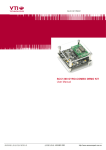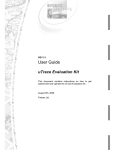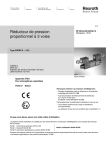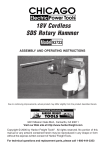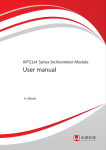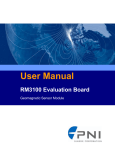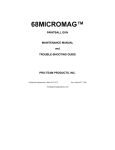Download User Manual
Transcript
User Manual
MagIC™
SmartSens High Data Rate Sensor Controller
1
2
3
4
5
6
7
8
COPYRIGHT & WARRANTY INFORMATION ............................................................ 3
INTRODUCTION .......................................................................................................... 4
SPECIFICATIONS ....................................................................................................... 5
TYPICAL OPERATING CHARACTERISTICS ............................................................ 7
DIMENSIONS AND PACKAGING ............................................................................... 9
OVERVIEW AND SET-UP ......................................................................................... 11
6.1
OVERVIEW ................................................................................................... 11
6.2
MAGIC PINOUT AND CONNECTIONS ........................................................ 12
6.2.1 SPI Port Lines ................................................................................... 15
6.2.2 Hardware Handshaking Lines .......................................................... 15
6.3
CLOCK OPTIONS ......................................................................................... 16
OPERATION .............................................................................................................. 17
7.1
MAKING A MEASUREMENT ........................................................................ 17
7.1.1 Slave Select (SSNOT) ..................................................................... 18
7.1.2 Idle Mode .......................................................................................... 19
7.1.3 SPI Interface Considerations ............................................................ 19
7.2
REGISTER DEFINITION ............................................................................... 20
SOLDERING .............................................................................................................. 22
Figure 4-1:
Figure 4-2:
Figure 4-3:
Figure 5-1:
Figure 5-2:
Figure 6-1:
Figure 6-2:
Figure 6-3:
Figure 6-4:
Figure 7-2:
Figure 8-1:
Maximum Data Rate per Axis vs. Period Select .................................................... 7
Gain vs. Period Select............................................................................................ 7
Sample Time per Axis vs. Period Select ................................................................ 8
MagIC Mechanical Drawing ................................................................................... 9
MagIC Tape Dimensions ..................................................................................... 10
MagIC and SmartSens Circuit Block Diagram ..................................................... 11
Biasing Diagram ................................................................................................... 11
Reference Sensor & Analog Mux Connections and Comparator Circuit ............. 14
Clock Configurations ............................................................................................ 16
SPI Interface Timing............................................................................................. 18
Recommended Solder Reflow Profile .................................................................. 22
Table 3-1:
Table 3-2:
Table 3-3:
Table 7-1:
Table 7-2:
Table 8-1:
Absolute Maximum Ratings .................................................................................... 5
Recommended Operating Conditions ..................................................................... 5
Timing Requirements .............................................................................................. 6
Command Register ............................................................................................... 20
Results Register .................................................................................................... 21
Recommended Solder Processing Parameters .................................................... 22
深圳市铭之光电子技术有限公司 全国服务热线 : 400-883-3391
http://www.sensorexpert.com.cn
1 Copyright & Warranty Information
© Copyright PNI Sensor Corporation 2009
All Rights Reserved. Reproduction, adaptation, or translation without prior written permission is prohibited, except as allowed under copyright laws.
Revised January 2010: for the most recent version visit our website at www.pnicorp.com
PNI Sensor Corporation
133 Aviation Blvd, Suite 101
Santa Rosa, CA 95403, USA
Tel: (707) 566-2260
Fax: (707) 566-2261
Warranty and Limitation of Liability. PNI Sensor Corporation ("PNI") manufactures its Products from parts and components that are new or
equivalent to new in performance. PNI warrants that each Product to be delivered hereunder, if properly used, will, for ninety (90) days following the
date of shipment unless a different warranty time period for such Product is specified: (i) in PNI’s Price List in effect at time of order acceptance; or (ii)
on PNI’s web site (www.pnicorp.com) at time of order acceptance, be free from defects in material and workmanship and will operate in accordance
with PNI’s published specifications and documentation for the Product in effect at time of order. PNI will make no changes to the specifications or
manufacturing processes that affect form, fit, or function of the Product without written notice to the Customer, however, PNI may at any time, without
such notice, make minor changes to specifications or manufacturing processes that do not affect the form, fit, or function of the Product. This warranty
will be void if the Products’ serial number, or other identification marks have been defaced, damaged, or removed. This warranty does not cover wear
and tear due to normal use, or damage to the Product as the result of improper usage, neglect of care, alteration, accident, or unauthorized repair.
THE ABOVE WARRANTY IS IN LIEU OF ANY OTHER WARRANTY, WHETHER EXPRESS, IMPLIED, OR STATUTORY, INCLUDING, BUT NOT
LIMITED TO, ANY WARRANTY OF MERCHANTABILITY, FITNESS FOR ANY PARTICULAR PURPOSE, OR ANY WARRANTY OTHERWISE
ARISING OUT OF ANY PROPOSAL, SPECIFICATION, OR SAMPLE. PNI NEITHER ASSUMES NOR AUTHORIZES ANY PERSON TO ASSUME
FOR IT ANY OTHER LIABILITY.
If any Product furnished hereunder fails to conform to the above warranty, Customer’s sole and exclusive remedy and PNI’s sole and exclusive liability
will be, at PNI’s option, to repair, replace, or credit Customer’s account with an amount equal to the price paid for any such Product which fails during
the applicable warranty period provided that (i) Customer promptly notifies PNI in writing that such Product is defective and furnishes an explanation of
the deficiency; (ii) such Product is returned to PNI’s service facility at Customer’s risk and expense; and (iii) PNI is satisfied that claimed deficiencies
exist and were not caused by accident, misuse, neglect, alteration, repair, improper installation, or improper testing. If a Product is defective,
transportation charges for the return of the Product to Customer within the United States and Canada will be paid by PNI. For all other locations, the
warranty excludes all costs of shipping, customs clearance, and other related charges. PNI will have a reasonable time to make repairs or to replace
the Product or to credit Customer’s account. PNI warrants any such repaired or replacement Product to be free from defects in material and
workmanship on the same terms as the Product originally purchased.
Except for the breach of warranty remedies set forth herein, or for personal injury, PNI shall have no liability for any indirect or speculative damages
(including, but not limited to, consequential, incidental, punitive and special damages) relating to the use of or inability to use this Product, whether
arising out of contract, negligence, tort, or under any warranty theory, or for infringement of any other party’s intellectual property rights, irrespective of
whether PNI had advance notice of the possibility of any such damages, including, but not limited to, loss of use, revenue or profit. In no event shall
PNI’s total liability for all claims regarding a Product exceed the price paid for the Product. PNI neither assumes nor authorizes any person to assume
for it any other liabilities.
Some states and provinces do not allow limitations on how long an implied warranty lasts or the exclusion or limitation of incidental or consequential
damages, so the above limitations or exclusions may not apply to you. This warranty gives you specific legal rights and you may have other rights that
vary by state or province.
深圳市铭之光电子技术有限公司 全国服务热线 : 400-883-3391
http://www.sensorexpert.com.cn
2 Introduction
Thank you for purchasing PNI Sensor Corporation’s SmartSens MagIC™ ASIC (PNI part
number 12739). The MagIC is a high-data-rate controller ASIC for use with PNI’s SmartSens
magneto-inductive (MI) sensors (the Sen-XY™ and Sen-Z™). It contains drive and
measurement circuitry for interaction with SmartSens sensors, interface circuitry to
communicate with a host microprocessor on an SPI bus, an internal clock and inputs for a usersupplied external clock or crystal oscillator. The MagIC can control and measure three
independent SmartSens sensors. Each SmartSens sensor is individually selectable for
measurement, and can be individually configured for measurement resolution
PNI’s SmartSens product line also includes the 11096 ASIC, MS2100™ single-chip solution,
and the MicroMag family (MicroMag2™, MicroMag3™, and MicroMagIC™). The main
differences between the MagIC and 11096 ASIC are the data rates and footprint, with the 11096
ASIC having a smaller footprint and the MagIC providing higher data rates. PNI’s MS2100 IC is
a single IC solution incorporating two SmartSens MI sensors and an 11096 ASIC, while PNI’s
MicroMag modules contain 2 or 3 SmartSens sensors and either the 11096 ASIC or MagIC.
For most applications the SmartSens MI sensor serves as the inductive element in a simple LR
relaxation oscillation circuit, with its effective inductance proportional to the magnetic field
parallel to the sensor axis. When driven by the MagIC, the frequency of oscillation varies with
the strength of the magnetic field parallel to the sensor.
The output from the MagIC is inherently digital and can be fed directly into a microprocessor,
which eliminates the need for signal conditioning or an analog/digital interface between the
sensor and a microprocessor. The simplicity of the SmartSens circuit combined with the lack of
signal conditioning makes it easier and less expensive to implement than alternative fluxgate or
magneto-resistive (MR) technologies.
Since the SmartSens circuit works in the frequency domain, resolution and noise are
established cleanly by the number of period counts. In comparison, fluxgate and MR
technologies require expensive and complex signal processing to obtain similar resolution and
noise, and for certain applications the SmartSens solution cannot be matched.
The user may wish to refer to PNI’s MicroMagIC User Manual to provide aid in the evaluation
and prototyping of the MagIC module.
深圳市铭之光电子技术有限公司 全国服务热线 : 400-883-3391
http://www.sensorexpert.com.cn
3 Specifications
Table 3-1: Absolute Maximum Ratings
Parameter
DC Supply Voltage for I/O
Symbol
Maximum
VCCIO
3.75 VDC
VCC
1.65 VDC
VIN
-0.3V to 3.6V
DC Supply Voltage for Core
Digital Input Voltage
CAUTION:
Stresses beyond those listed Table 3-1 may cause permanent damage to the device. These are
stress ratings only. Functional operation of the device at these or any other conditions beyond
those indicated in the operational sections of the specifications is not implied. Exposure to
absolute maximum rating conditions for extended periods may affect device reliability.
Table 3-2: Recommended Operating Conditions
Parameter
for I/O
Supply Voltage
for Core
Bias Resistance
1
Operating Current
measured at VCC
Symbol
Min
Typ
Max
Unit
VCCIO
2.7
3.0 or 3.3
3.6
VDC
VCC
1.425
1.5
1.575
VDC
VCCIO = 3.0 V
Rb
53
Ω
VCCIO = 3.3 V
Rb
62
Ω
PS = 32, 80 Hz
1.7
mA rms
PS = 1024, 37 Hz
3.6
mA rms
55
µA
5
pF
VCCIO
V
Idle Mode Supply Current
Digital Output
Digital Input
Temperature
External load capacitance at
each output pin to ground.
CL
High level output voltage
VOH
Low level output voltage
VOL
Input Capacitance
CIN
High level input voltage
VIH
Low level input voltage
VIL
High level input current
IIH
10
µA
Low level input current
IIL
10
uA
2.4
0
0.4
V
8
pF
2
3.6
V
-0.3
0.8
V
Operating
-40
+85
C
Storage
-65
+150
C
深圳市铭之光电子技术有限公司 全国服务热线 : 400-883-3391
http://www.sensorexpert.com.cn
Note:
1) “PS” is the “period select”, which is set by the user in software, and is inversely proportional to the
data rate, as show in Figure 4-1. Minimum PS = 8 and Maximum PS = 4095. The listed data rate is
per axis.
Table 3-3: Timing Requirements
Parameter
Min
Clock frequency
Typ
1
Max
Unit
MHz
Pulse duration low
0.45*tSCLK
ns
Pulse duration high
0.45*tSCLK
ns
深圳市铭之光电子技术有限公司 全国服务热线 : 400-883-3391
http://www.sensorexpert.com.cn
4 Typical Operating Characteristics
Note that “Period Select” is set by the user in software.
Figure 4-1: Maximum Data Rate per Axis vs. Period Select
Figure 4-2: Gain vs. Period Select
(Resolution = 1/Gain, to the system’s noise limit)
深圳市铭之光电子技术有限公司 全国服务热线 : 400-883-3391
http://www.sensorexpert.com.cn
Figure 4-3: Sample Time per Axis vs. Period Select
深圳市铭之光电子技术有限公司 全国服务热线 : 400-883-3391
http://www.sensorexpert.com.cn
5 Dimensions and Packaging
Dimensions in mm.
Figure 5-1: MagIC Mechanical Drawing
深圳市铭之光电子技术有限公司 全国服务热线 : 400-883-3391
http://www.sensorexpert.com.cn
Figure 5-2: MagIC Tape Dimensions
深圳市铭之光电子技术有限公司 全国服务热线 : 400-883-3391
http://www.sensorexpert.com.cn
6 Overview and Set-Up
6.1 Overview
The MagIC ASIC is intended as a component in a SmartSens magnetic measurement
circuit, as show in Figure 6-1, with a detail of how the biasing works in Figure 6-2.
Figure 6-1: MagIC and SmartSens Circuit Block Diagram
Figure 6-2: Biasing Diagram
深圳市铭之光电子技术有限公司 全国服务热线 : 400-883-3391
http://www.sensorexpert.com.cn
The MagIC’s output reading provides the difference in the high-speed oscillator period
counts between forward-biased and reverse-biased sensor measurements. To make a
measurement, one side of the sensor is grounded while the other side is alternately driven
with positive and negative current through the oscillator. The Period Select is user-defined
in software and establishes how many oscillations of the RL circuit are desired per
measurement. The greater the Period Select, the higher the resolution of the measurement
and the longer the sample time. The high-speed oscillator measures how long it takes to
make the desired number of RL circuit oscillations. The MagIC will then switch the bias
connection to the sensor and make another measurement. The side that was previously
grounded is now charged and discharged while the other is now grounded. The MagIC can
be used to interface from one to three sensors depending on application requirements:
unused sensor connections should remain floating. The MagIC contains drive and
measurement circuitry for interaction with PNI’s SmartSens magneto-inductive sensors,
interface circuitry to communicate with a host microprocessor on an SPI bus, an internal
clock and inputs for an optional external clock or crystal oscillator
6.2 MagIC Pinout and Connections
The MagIC’s pinout is summarized in Table 6-1. The pinout runs counterclockwise on the
MagIC (when looking from the top), starting at the Pin 1 designator as shown in Figure 5-1.
As indicated in Figure 6-1, implementation of the MagIC requires incorporation of a usersupplied analog multiplexer and comparator. Figure 6-3 (below) provides reference circuit
information for incorporating a Texas Instruments 74HC4051 analog multiplexer and Texas
Instruments LMV761 comparator.
深圳市铭之光电子技术有限公司 全国服务热线 : 400-883-3391
http://www.sensorexpert.com.cn
Table 6-1: MagIC Pinout
Pin#
Pin Name
Description
1
MUXA0
Analog MUX Channel Select Address Output
2
MUXA1
Analog MUX Channel Select Address Output
3
MUXA2
Analog MUX Channel Select Address Output
8,24,46,61
VCC
1.5V Supply for Core
9,25,45,60
GND
Ground Pins
10,26,44,59
VCCIO
3.3V Supply For I/O
12
MGSW_SD
Shutdown Signal Output To Analog MUX
14
~YDRV
Y Sensor Negative Drive Signal Output
16
YDRV
Y Sensor Positive Drive Signal Output
17
XDRV
X Sensor Positive Drive Signal Output
18
~SLEEPMODE
Disabled
20
~XDRV
X Sensor Negative Drive Signal Output
22
~ZDRV
Z Sensor Negative Drive Signal Output
23
ZDRV
Z Sensor Positive Drive Signal Output
27
SSNOT
SPI Slave Select (Negative True)
28
DRDY
Data Ready Output
32,33,34,36,37
TEST
Do not connect
35
TSTP
Pin should be tied to ground
38
TSTJ
Pin should be tied to ground
39
MOSI
SPI Serial Data Out (Master Out Slave In)
40
MISO
SPI Serial Data Out (Master In Slave Out)
41
SCLK
SPI Serial Clock Input
42
CLK_IN
External Clock Input
43
RESET
Reset Input
47
CLK_OUT
High-Speed Clock Output
48
CLK_DIV
Internal Clock Speed (LOW=High-Speed, HIGH=HighSpeed/2)
49
INT_EXT_CLK
Clock Select Input (LOW=Internal, HIGH=External)
50
CLK_OUT_ENBL
High-Speed Clock Enable Output (HIGH=Enable)
67
MAG_OUT
Mag Oscillator Output (a MagIC Input)
68
~MAG_SD
Negative Shutdown Signals to Peripherals (Output)
4,5,6,7,11,13,15,19,21,
29, 30,31,51–58,62-66
NC
No Connection
深圳市铭之光电子技术有限公司 全国服务热线 : 400-883-3391
http://www.sensorexpert.com.cn
Figure 6-3: Reference Sensor & Analog Mux Connections and Comparator Circuit
深圳市铭之光电子技术有限公司 全国服务热线 : 400-883-3391
http://www.sensorexpert.com.cn
6.2.1 SPI Port Lines
SCLK (SPI Serial Clock Input)
An SPI input is used to synchronize the data sent in and out through the MISO and
MOSI lines. SCLK is generated by the customer-supplied master device and should
be 1 MHz or less. One byte of data is exchanged over eight clock cycles. Data is
captured by the master device on the rising edge of SCLK. Data is shifted out and
presented to the MagIC on the MOSI pin on the falling edge of SCLK.
SSNOT (SPI Slave Select)
This signal sets the MagIC as the operating slave device on the SPI bus. The
SSNOT line must be LOW prior to data transfer in either direction, and must stay
LOW during the entire transfer. The SPI bus can be freed up (SSNOT line set HIGH)
for communication with another slave device while the MagIC is taking a
measurement or idle, but after all communication between the MagIC and master
device is finished.
MISO (SPI Serial Out)
An SPI output that sends data from the MagIC to the master device. Data is
transferred most significant bit first and is captured by the master device on the rising
edge of SCLK. The MISO line is placed in a high impedance state if the MagIC is
not selected as the slave (SSNOT=1).
MOSI (SPI Serial In)
An SPI input that provides data from the master device to the MagIC. Data is
transferred most significant bit first. Data must be presented at least 100 ns before
the rising edge of SCLK, and remain valid for 100 ns after the edge. New data may
be presented to the MOSI pin on the falling edge of SCLK.
6.2.2 Hardware Handshaking Lines
RESET (Reset)
RESET must be toggled LOW-HIGH-LOW before sending a measurement
command. RESET is usually LOW.
DRDY (Data Ready)
深圳市铭之光电子技术有限公司 全国服务热线 : 400-883-3391
http://www.sensorexpert.com.cn
It is recommended the DRDY line be used to ensure data is clocked out of the
MagIC only when it is available. DRDY is set low after a RESET. After a command
has been received and the data is ready, DRDY will be changed to high.
6.3 Clock Options
The MagIC can be configured for various high-speed clock options, including selection of:
internal or external clock (INT_EXT_CLK, pin 49), outputting or not outputting the clock
(CLK_OUT_ENBL, pin 50), and dividing the clock rate by 2 (CLK_DIV, pin 48). Pins 48, 49,
and 50 should not be left floating: rather they should be either tied to ground or VCC.
Figure 6-4: Clock Configurations
深圳市铭之光电子技术有限公司 全国服务热线 : 400-883-3391
http://www.sensorexpert.com.cn
7 Operation
Data flow to and from the MagIC is through a hardware handshaking, synchronous serial
interface that adheres to the SPI bus protocol. Section 6 reviews the various interface lines and
provides brief descriptions of some of their functions.
(The MagIC ASIC interface is based on PNI’s 11096 ASIC interface except the command is
changed from 8 bit to 32 bit. The new command word contains similar sensor axis select bits
together with startup and period preset values. The measured result is now extended to signed
20bit value, compared to 16 bit in the PNI’s 11096 ASIC.)
7.1 Making a Measurement
The steps to make a sensor measurement are given below, and the sequence and timing
are given in Figure 7-1 and Figure 7-2. In general, the user sends a command word (see
Section 7.2) to the MagIC through the SPI line specifying the sensor to be measured, the
period select, and the startup counter. The MagIC returns the result of a complete forwardreverse measurement of the sensor in a 20-bit 2’s complement format (range: -524288 to
524287). Note that only one sensor can be measured at a time.
1. SSNOT is set LOW. (This enables communication with the master device.)
2. RESET pin set HIGH, then LOW. This will reset the MagIC.
3. A command word is clocked into the MagIC on the MOSI line. Once 32 bits have
clocked in, the MagIC will execute the command (take a measurement).
4. A measurement consists of forward biasing the sensor and making a period count;
then reverse biasing the sensor and counting again; and then taking the difference
between the two directions.
5. At the end of the measurement, the DRDY line is set HIGH, indicating data is ready.
The data is clocked out on the MISO line with the next 20 clock cycles.
深圳市铭之光电子技术有限公司 全国服务热线 : 400-883-3391
http://www.sensorexpert.com.cn
Figure 7-1: Sequence Diagram of SPI Interface
Figure 7-2: SPI Interface Timing
7.1.1 Slave Select (SSNOT)
Keeping the SSNOT line LOW dedicates the master device to the MagIC. If the user
has no other slave devices, the SSNOT line can be permanently grounded. Conversely,
if the user has multiple slave devices, then the SPI bus can be freed up for other devices
by bringing the SSNOT line HIGH. The SSNOT line can be brought HIGH either:
•
after sending the command word on the SI line but before reading the
measurement data on the MISO line, and/or
深圳市铭之光电子技术有限公司 全国服务热线 : 400-883-3391
http://www.sensorexpert.com.cn
•
after receiving the measurement data on the MISO line, but before initiating
another measurement sequence.
Note: If a new command sequence is started before a previous measurement has been
read out, that previous data will be flushed out.
7.1.2 Idle Mode
The MagIC incorporates an idle mode to reduce power consumption, in which it
automatically idles when it is not exchanging data or taking a measurement. However, it
does not necessarily initialize in the idle mode at power-up. To ensure the MagIC will be
in idle mode after being turned on, it is necessary to cycle the MagIC through one
measurement request operation. The measurement data does not need to be read out.
7.1.3 SPI Interface Considerations
When implementing an SPI port, whether a dedicated hardware peripheral port or a
software-implemented port using general purpose I/O (also known as Bit-Banging), the
timing parameters (given in Figure 7-2) must be met to ensure reliable communications.
When SCLK is LOW, the data is in transition (tDBSH = Time, Data Before SCLK High).
The clock set-up and hold times, tDBSH and tDASH must be greater than 100 ns. The clock
phase used with the MagIC is zero (CPOL-0). Data is present (MISO) or should be
presented (MOSI) before the first low to high clock transition.
Also note that an SPI port can be implemented using different clock polarity options. The
clock polarity used with the MicroMagIC must be normally low, (cpol = 0). Data always
is considered valid while SCLK is high (tDASH = Time, Data After SCLK High). When
SCLK is low, data is in transition (tDBSH = Time, Data Before SCLK High).
深圳市铭之光电子技术有限公司 全国服务热线 : 400-883-3391
http://www.sensorexpert.com.cn
7.2 Register Definition
Table 7-1: Command Register
Bit
Name
Description
31:24
Command
Command Register. Initiates a sensor measurement
Bits are named as follows:
31
30
29
28
27
26
25
ODIR MOT ASI
24
AS0
ODIR Oscillator Direction
Determines the magnetic oscillator direction if MOT is
set to HIGH. If MOT is set LOW, ODIR has no effect.
Used for debug only.
MOT Magnetic Oscillator Test
When set HIGH, causes the sensor oscillator selected
by AS0 and AS1, in the direction selected by ODIR to
run continuously until the Reset pin is set HIGH.
AS0-AS1 Axis Select
Determines sensor to be measured.
Function
AS1
AS0
X
0
1
Y
1
0
Z
1
1
23:16
Startup Counter
Preset Value
5 bit unsigned Startup Counter Preset Value.
(Bit 21 to 23 will be ignored). Default = 0x0F
Configures how many Mag oscillator cycles to count
before starting the forward or backward measurement.
15:0
Period Counter
Preset Value
12 bit unsigned Period Counter Preset Value. (Bit 12
to 15 will be ignored).
Configures how many Mag oscillator cycles to count
during a forward or backward measurement.
深圳市铭之光电子技术有限公司 全国服务热线 : 400-883-3391
http://www.sensorexpert.com.cn
Table 7-2: Results Register
Bit
Name
Description
19:0
Measured Sensor
Value
Returns measured sensor value in a 20 bit signed
value with ranges from -219 to 219-1 (2’s complement
number). Zero’s will be returned on MISO if more than
20 SCLK’s are sent during a read.
深圳市铭之光电子技术有限公司 全国服务热线 : 400-883-3391
http://www.sensorexpert.com.cn
8 Soldering
Table 8-1: Recommended Solder Processing Parameters
Reflow Parameter
Temperature (C)
Preheat Temperature (Tsmin To Tsmax)
Temperature Tl (Typical Lead-Free Solder
Melting Point)
TIME (sec)
150°C – 200°C
60-180
>218°C
Tsmax To Tl Ramp-Up Rate
3°C/Second Max
Peak Temperature Tp
<260°C
Time 25°C To Peak Tp
6 Minute Max
Time Maintained Above Temperature Tl (Tl)
218°C
60-120
Soak (Time Within 5° Of Actual Peak Tp)
Rampdown Rate
10-20
4°C/Second Max
a. Meets IPC/JEDEC J-STD-020 profile recommendations
PB
Figure 8-1: Recommended Solder Reflow Profile
深圳市铭之光电子技术有限公司
传感器专家网
E-mail: [email protected]
Tel: 400-883-3391
Web : www.sinocomopto.com
Web : www.sensorexpert.com.cn
深圳
上海
北京
香港
地址:深圳市福田区天安数
地址:上海市普陀区江宁路1165
地址:北京海淀区中关村东路
地址:香港葵涌嘉庆路12号港
码城创新科技广场1期A座401
号圣天地商务中心705室
66号世纪科贸大厦C座1003室
美中心1004室
电话:(86)0755-83439588
电话:(86)021-52527755
电话:(86)010-62672430
电话:(852)24208555
传真:(86)0755-83433488
传真:(86)021-52522211
传真:(86)010-62672433
传真:(852)24200055
























